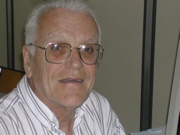CURRICULUM VITAE
S. Bratos was born in Trieste, Italy. He graduated in 1951 in physics at the University of Ljubljana, Slovenia. He prepared two PhD�s, a first in 1955 on characteristic vibrational frequencies under supervision of Prof. D. Hadzi of the University of Ljubljana, and a second in 1964 on infrared spectra of compressed gases under supervision of Prof. R. Daudel of the University of Paris. He was successively Attaché Chargé and Maitre de Recherche in the Centre National de la Recherche Scientifique (CNRS), France. In 1969 he was appointed Associated, and in 1973 Full Professor of Physics at the University Pierre et Marie Curie (Paris 6). Actually, he is Professor Emeritus of the same University. He created and chaired the Liquids Section of the European Physical Society from 1983 to 1991, and a Research Grouping on Ultra fast Chemical Reactivity in Liquids from 1992 to 2000. In 1987, he was elected Corresponding Member, the Slovenian Academy of Sciences and Arts, and in 1995 Full Member of the European Academy of Arts, Sciences and Humanities. The same year the University Pierre and Marie Curie honoured him with a medal of this University. Moreover, in 1999 Polish Academy of Sciences and Arts in Krakow, and in 2000 Polish Academy of Sciences in Warsaw elected him Foreign Member of these institutions. Finally, in 2006, University of Wroclaw conferred on him the title of Doctor Honoris Causa.
SCIENTIFIC ACTIVITY
Scientific activity of S. Bratos mainly concerns molecular dynamics of liquids, studied by the help of statistical mechanics. Several domains were explored in this way. He first examined infrared and Raman band shapes of chemically inert solutions. A method permitting to separate spectral effects of vibrational and rotational motions resulted from this study. This method is of current use today. A second research domain was that of infrared band shapes of hydrogen bonded liquids. Spectral characteristics of H-bonding were attributed to the anharmonicity of OH�O vibrations. The acceptation of this proposal was slow, and required more than ten years of passionate discussions. The recent work of S. Bratos concerns ultra fast infrared spectroscopy and ultra fast x-ray diffraction from liquids. These two techniques permit to �film� atomic motions during a chemical reaction in real time. Using infrared techniques, he and G. Gale succeeded to monitor OH�O motions in water on femto second time scales. Finally, employing ultra fast x-ray diffraction techniques, he and M. Wulff succeeded to �film� recombination of the photo - dissociated iodine molecule in solution. Hundred years after Roentgen, Bragg and Laue, real time monitoring of atomic motions by x-rays thus became possible.
SELECTED PAPERS
- Infrared study of liquids. (I) Theory of infrared spectra of diatomic molecules in inert solutions, J. Chem. Phys. 52 (1970), 439 (with J. Rios and Y. Guissani).
- Raman study of liquids. I. Theory of Raman spectra of diatomic molecules in inert solutions, Phys. Rev. A4 (1971), 1078 (with E. Mar�chal).
- Infrared spectra of molecules with hydrogen bonds, J. Chem. Phys. 27 (1957), 991 (with D. Hadzi).
- Profiles of hydrogen stretching IR bands of molecules with hydrogen bonds: a stochastic theory. I. Weak and medium strong hydrogen bonds, J. Chem. Phys. 63 (1975), 3493.
- Profiles of hydrogen stretching IR bands of molecules with hydrogen bonds. A stochastic theory. II. Strong hydrogen bonds, J. Chem. Phys. 76 (1982), 77 (with H. Ratajczak).
- Ultra fast infrared pump-probe spectroscopy of water: a theoretical description, J. Chem. Phys. 101 (1994), 4536 (with J-Cl. Leicknam).
- Femto second dynamics of hydrogen bonds in liquid water: a real time study, Phys. Rev. Lett. 82 (1999), 1068 (with G.M. Gale, G. Gallot, F. Hache, N. Lascoux and J-Cl. Leicknam).
- Time-resolved x-ray diffraction: statistical theory and its application to the photo-physics of molecular iodine, J. Chem.Phys. 116 (2002), 10615 (with F. Mirloup, R.Vuilleumier and M. Wulff ).
- Visualizing chemical reactions in solution by pico second x-ray diffraction, Phys. Rev. Lett. 92 (2004), 125505 (with A. Plech, M. Wulff, F. Mirloup, R.Vuilleumier, F. Schotte and Ph. A. Anfinrud).





